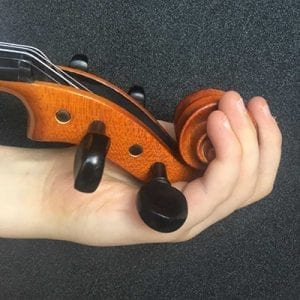Measuring a violin’s size requires measuring the length of the body. To measure the violin size, measure the length of the body from the bottom of the instrument to the neck joint.
A violin is a musical instrument that comes in different sizes. The correct size is important for proper playability and comfort. Choosing the right size can be challenging, especially if you are a beginner. Measuring the correct violin size is essential to ensure musicians can play comfortably and develop their skills effectively.
The size of a violin is determined by the length of its body, with different sizes available for different age groups and body types. In this article, we will discuss how to measure violin size accurately. Following these simple steps, you can determine the right size of a violin that suits you best.

Credit: musicalinstrumenthire.com
Understanding Violin Sizes
Understanding violin sizes is crucial when learning how to play this beautiful instrument. There are different sizes available, and finding the right one for the player’s age and arm length is essential. Measurements typically range from 1/16 to 4/4, with the latter being the full size.
A violin that is too small or too big can lead to discomfort, difficulty in playing, and even injury. It’s essential to measure the arm’s length from the base of the neck to the middle of the palm to determine the right size.
Keep in mind that children may need to switch to larger sizes as they grow. By following these guidelines, the player can achieve optimal comfort and performance while playing the violin.
Measuring Arm Length For Violin Size
Are you looking for the right violin size that fits your arm’s length? Measuring arm length can be tricky, but with the proper techniques, you can get an accurate measurement. When it comes to measuring your arm length, make sure to keep your arm straight and measure from the base of your neck to the middle of your palm.
Additionally, factors such as your age and level of experience are essential factors to consider when determining violin size. For children, alternative methods of measuring their arm length, such as using a paper template or measuring with a ruler, can be helpful.
Remember, finding the right size is crucial for creating beautiful music and avoiding discomfort or injury.
Taking Body Measurements For Violin Size
Measuring the size of a violin is an essential step in playing the instrument. To determine the right size, accurate measurements of each body part are needed. The standard measurements include the arm length, finger span, and neck length. Each measurement should be adjusted according to the age of the player.
For instance, a child would need a smaller violin than an adult. To measure each part, you must use a measuring tape to get the correct size. Measuring a violin is a simple process, but it requires attention to detail.
With the right techniques and measurements, you can discover the proper violin size for you or your child.
Comparing Violin Sizes With Body Measurements
Choosing the right violin size is crucial for both beginners and experienced musicians. It is important to measure your body in order to determine the appropriate size of the instrument. Comparing body measurements with violin sizes can be a daunting task, but with the right guidance, it can be easy.
Understanding how to measure violin size will help you find the perfect instrument for maximum playing comfort and efficiency. Different violin sizes are suitable for different age groups, so it is important to choose the right size in order to achieve the best possible sound and playability.
With the right amount of research and understanding, finding the perfect violin size can be an enjoyable and rewarding experience.
Conclusion
After learning how to measure violin size, it is important to make sure you are choosing the right instrument for your needs. Taking the time to measure accurately and determine the right size can make a huge difference in your playing experience.
Knowing the correct size for you will ensure that you can comfortably and confidently play your violin. In addition, it is also important to consider the quality of the instrument, and how it fits into your budget. A properly sized, high-quality violin can help you develop your skills and sound better, while also lasting for years to come.
By following these steps and considerations, you can make an informed decision when selecting a violin and begin your journey into the beautiful world of music.
Frequently Asked Questions On How To Measure Violin Size
What Is The Right Size Of Violin For A Child?
The right size of violin for a child depends on their age and arm length. You can measure your child’s arm to determine which size is best for them.
How Do I Measure A Child’S Arm For A Violin?
To measure a child’s arm for a violin, have them stand up straight with their arm extended to the side. Measure from their neck to the middle of their palm. This determines the length of the violin needed.
Can Adults Use The Same Size Violin As Children?
No, adults cannot use the same size violin as children. Violins come in various sizes and choosing the right size is important for proper posture and technique. Adults generally need a full-sized violin.
Should I Rent Or Buy A Violin For A Beginner?
It’s recommended to rent a violin for a beginner, especially for children. As the child grows and progresses, they may need a larger size violin. Renting allows for easy size exchanges and the ability to upgrade as their skill level improves.
What Other Factors Should I Consider When Choosing A Violin Size?
In addition to age and arm length, other factors to consider when choosing a violin size include the player’s comfort, body shape, and skill level. It’s important to choose a size that allows for proper posture and technique, and one that the player feels comfortable with.

